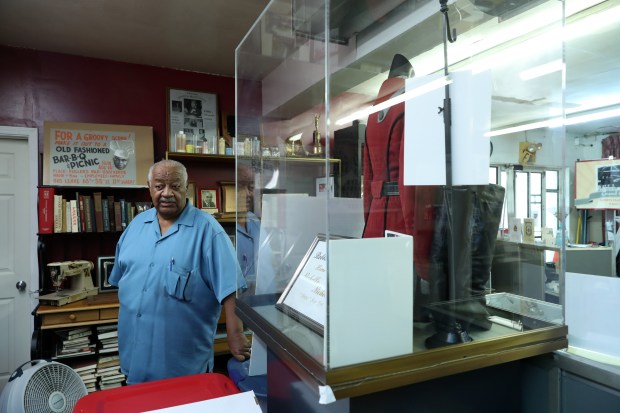Tyrone Haymore was a longtime resident of Robbins and, with his decades of service as an elected official and as head of its historical society, one also could call him the village’s greatest ambassador and champion.
“He absolutely, absolutely loved this village,” said Robbins Village Clerk Sharon Dyson. “He was so proud of all the history that is Robbins and being able to document it and get it out to the world, in whatever venue. He was proud of the heritage that he was able to do in terms of keeping that history alive.”
Haymore, 78, died May 3, according to the W.W. Holt Funeral Home in Harvey. Haymore was a longtime Robbins resident.
Haymore was the son of a former sharecropper father from Lexington, Mississippi, who moved the family from Chicago’s Bronzeville to Robbins in 1949. In a 2004 Tribune interview, Haymore recalled the Robbins of his boyhood as a place where one “could live real nice and eat beans and greens.”
Haymore attended Thornton Junior College — now South Suburban College — before embarking on a long career with the Chicago Transit Authority.
Concurrently, Haymore was a Robbins village trustee and then was elected the village’s clerk in 1989. He later returned to being a trustee for several terms.
In 1980, Haymore started the Robbins Historical Society with several others, including a woman named Eddie Lou Allen. Dating back to his high school years, Haymore had developed a keen appreciation for the many notable African Americans from Robbins.
They include cellophane inventor and former Mayor Earl Nichols, the former mayor’s actress daughter Nichelle Nichols, early Black multimillionaire and cosmetics magnate Samuel B. Fuller and aviators Cornelius Coffey and John Robinson, who along with Chicagoan Bessie Coleman founded the short-lived Robbins Airport, which was the nation’s first Black airport and school of aviation in Robbins.
Haymore authored a Robbins coloring book as a teaching tool in the mid-1990s.
“In Black History Month, he was always booked to appear at schools and before different organizations to tell the history,” Dyson said.
After retiring from the CTA, Haymore devoted himself to Robbins’ history, and eventually to creating a permanent location for exhibits. He took on the role of executive director of the Robbins History Museum, and for many years stored numerous artifacts in his home.
Despite Robbins’ well-documented struggles, Haymore remained upbeat and hopeful about the potential for the community despite unemployment, poverty and disinvestment.
“We’re left with nothing but our history,” he told the Tribune in 2004. “If we don’t do anything with that, they may take that away too. This is what I choose to do with my retirement. I’m going to save Robbins’ history.”
In 2010, Haymore opened a permanent location for the Robbins History Museum, in an old storefront at 3644 W. 139th St. Later, Haymore oversaw the Robbins History Museum’s acceptance of a donation: the glassy, one-story former S.B. Fuller house at 135th Street and South Kedzie Avenue. Abandoned for a decade, the mid-century, modern-style home, donated as a tax write-off, had potential, but its days of opulence were long behind it.
“It’s in pretty bad shape,” Haymore told the Daily Southtown in 2022. “I think that’s why they gave it to me. Nobody wanted it anymore because it had been vandalized so badly. That house has six bathrooms and they pulled the plumbing out of all six of them. All the electric wiring has been pulled out. When people left out of there, they left it wide open, and the vandals did their job.”
Haymore accepted the donation because the Robbins History Museum had outgrown its home on 139th Street.
“The Fuller home is five times larger than our current building,” Haymore told the Tribune in 2022. “And we do need to preserve Mr. Fuller’s history as well. Taking on the responsibility of that house was something we really had to think about, but we really didn’t have a choice. So we reluctantly accepted it.”
The museum continues to operate from the 139th Street location, as fundraising has not been sufficient to pay for renovations to the former Fuller home.
“I’m the last one alive from the original historical society,” Haymore told the Tribune in 2004. “And it scares me to death. It scares me that Robbins’ history will be buried with me.”
There were no immediate survivors.
Bob Goldsborough is a freelance reporter.





